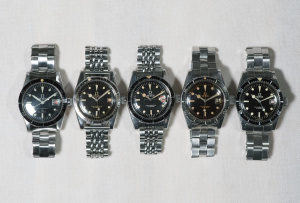Titus Calypsomatic

Titus Calypsomatic
"Calypso-matic is a new achievement by Solvil and Titus, a technical masterpiece giving one more example of the superior quality which makes the world wide tradition of Geneva watchmaking."
The Titus Calypsomatic was first introduced in the early 1960’s, likely between 1960 to early 62 and successfully ran in production through the early 70's. The 60’s were the golden years for vintage divers as many would call it. With the significant increase in commercial work in the ocean and seas the demand for well made, robust, waterproof watches took off. This created a field of strong competition and demand and as a result some of the best dive watches were produced in the 60’s. Like other brands looking to compete in such a booming industry, Titus introduced the beloved Calypsomatic.
During this era Jacques Cousteau was a very prominent figure, especially for under water diving both for personal and commercial activity. He essentially was gifted what was originally an old 40's British military WW2 ship that was used for minesweeping, which was later converted to a ferry and then refurbished and transformed by Cousteau into an expedition vessel to be a support for base diving, oceanographic research and even filming. During this transition the ship was named "Calypso" after the greek mythological character. Which in greek also mean, she who conceals. So by the time the 60's began, the name "Calypso" was already well known and documented and I am sure Titus was familiar with Cousteau and his ship and this could have inspired the first part of the name "Calypso".
Adding the "matic" at the end was likely because the watch housed an automatic ETA movement. The word auto-matic broken down simply means "willing to self-perform". * During this time period the automatic was still a big deal and was a significant selling point in advertisements.
Titus also made co-branded Calypsomatic models for Dacor but they are not gilt and have mercedes hands.
History

The first execution for the Calypsomatic was the reference 5913. The gilt print stopped being used around 1967 along with the famous lollipop hour hand. The reference 7985 was the last with this complete configuration and you see the changes immediately with the following 7986 reference. Transitional (very early) 7986 references may have a gilt dial and if you are lucky still the lollipop hour hand but its unlikely in most cases.
Case
The case is beautifully designed and was shared amongst a few other models such as the Universal Geneve Polerouter Sub and the Technos Sky Diver just to name a few. As a utilitarian watch it has the practical drilled lug-holes and pointed downward bending lugs that wrap nicely over the wrist.
- Waterproof rated for 20 ATM or 200 meters.
- All Calypsomatics feature a screw back case.
- Diameter without crown: ~37.3mm
- Top lug to bottom lug (on the same side): ~47.7mm
- Lug width: 20mm
- Thickness for most models: ~13-13.5mm thick from top of the crystal to center of the case-back.
Movement
The Calypsomatic uses an ETA2452 for the first generation and the ETA2472 movement for the rest. The 2472 is a mechanical movement with automatic winding, date display with semi-quickset feature, and power reserve of 42 hours.
5913 - 1st Generation Calypsomatic

The first execution for the Calypsomatic is the 5913, some including 5913-a on the case. Although there are a couple variations of the 5913 as a reference itself the first generation has a very specific dial, hands and crown that differentiates itself from the rest.
The dial itself is a highly desired gloss dial. The glossy finish is susceptible to some cracking, spider lines and scratches so expect to see them similar to most glossy dials of its period. While the other early Calypsomatic used gilt (gold text) for the print of the logo and writing of the words, the first generation used white print over the glossy finish. This was also used for the minute track, the surrounds around the lume plots and the date window box. A spectacular feature when you examine the dial is that the lume plots are connected to the hash marker, a feature also known as a lollipop. Something to notice is the lume plots should be neat but relatively tall and you should be able to see the white paint around the plots boarders for the original finish. A sloppy finish could indicate a relumed job. The dial also has a distinct star located between the words “Calypsomatic” and “21 Jewels”. This was exclusively used on the first generation dial. Also, below the 6 o’clock marker should state the word “swiss”. There is no “T” denoting tritium because the first generation used radium for the luminous material.
